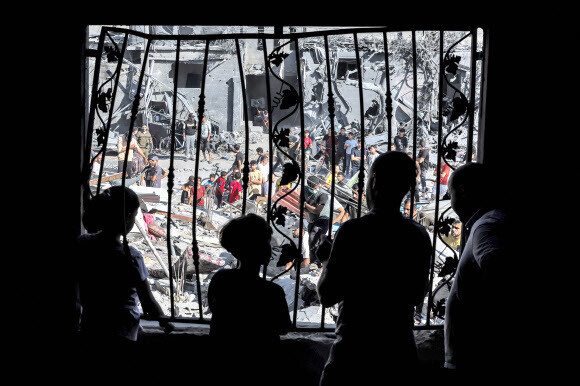
Palestinians in Rafah, a city in southern Gaza, peer at the wreckage of buildings brought down by Israeli bombing from behind bent metal bars on a window without a pane on Oct. 31. (AFP/Yonhap)
The number of people dead and missing in the Gaza Strip, which is currently being subjected to Israel’s blockade and attack, has reportedly exceeded 10,000. Brushing aside the international community’s demand for a ceasefire, Israel is expanding its ground operation. There seems to be no end to the misery and tragedy.
The UN Office for the Coordination of Humanitarian Affairs announced on Monday that as of that day, a total of 8,309 people had died in the Gaza Strip while 1,950 had gone missing since the beginning of Israel’s war with Hamas on Oct. 7. That brings the total number of individuals dead and missing in the region to over 10,000.
The majority of the missing are estimated to be buried under the rubble of buildings destroyed by bombing. Chances are high that many of them have passed away, as rescue operations have been all but impossible.
Children (3,747), women (2,062), and the elderly (460) accounted for 67 percent of the total death toll.
A Palestinian journalist working in the Gaza Strip even released a video he recorded himself that showed an Israeli tank targeting a car full of civilians, killing an entire family.
Those who still have their lives are also experiencing extreme suffering. Relief supplies arriving in the Gaza Strip on a handful of trucks as if to taunt are far from enough for the 2.2 million Gaza residents gripped with hunger, despair and fear. With supplies of necessities like food and water severed, Gazan society is crumbling, with residents looting UN relief storehouses.
Children who have witnessed bombs dropping right before them while evacuating are suffering from severe psychological wounds and fear.
The approaching reality is even more frightening. The Israeli military is closing in on Gaza City, the largest city in the Gaza Strip, surrounding it on three sides, while hundreds of tanks and armored cars advance into the strip. If a full-scale ground war begins soon, it’s difficult to predict how many civilians will be killed in the crossfire.
Although many in the international community are demanding a ceasefire to resolve the humanitarian crisis, Israeli Prime Minister Benjamin Netanyahu made clear on Monday that he would not agree to a ceasefire in the Gaza Strip following a wartime cabinet meeting. Likening calls for a ceasefire to “calls for Israel to surrender to Hamas, to surrender to terrorism, [and] surrender to barbarism,” Netanyahu went on that he would not stop until Hamas is eradicated.
The UN Security Council, whose purpose is to maintain international order, has not been able to do anything to prevent these horrors, paralyzed by a tug-of-war between powerful nations. During a UNSC meeting called on Monday to demand Israel’s acceptance of a humanitarian ceasefire, the US strongly defended Israel’s position.
If pain and despair continue in the Gaza Strip, war and anger will spread across the Middle East, and the world will pay the price.
Please direct questions or comments to [
english@hani.co.kr]




